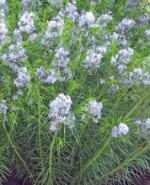 I bought my first Arkansas bluestar at a Master Gardener’s Fall plant sale. It was a puny little plant but since I had never had one but had always heard they were great garden plants, I bought it for 25 cents. I didn’t get around to planting it until the following year but it survived. It did nothing the first year but since I always give a new plant at least 2 years before pitching it this one was given another chance. That second year in the garden the large clump that emerged from the soil produced clusters of light blue flowers above delicate, fine foliage. The flowers only last a couple of weeks but the foliage provided a nice contrast with the other plants in the border and provides a lovely backdrop for lower growing annuals and perennials all summer long. In fall the foliage turns bright yellow and adds a really spectacular bright spot in the garden. A native of south central US, it does well in borders, cottage gardens, rock gardens, and open woodland gardens.
I bought my first Arkansas bluestar at a Master Gardener’s Fall plant sale. It was a puny little plant but since I had never had one but had always heard they were great garden plants, I bought it for 25 cents. I didn’t get around to planting it until the following year but it survived. It did nothing the first year but since I always give a new plant at least 2 years before pitching it this one was given another chance. That second year in the garden the large clump that emerged from the soil produced clusters of light blue flowers above delicate, fine foliage. The flowers only last a couple of weeks but the foliage provided a nice contrast with the other plants in the border and provides a lovely backdrop for lower growing annuals and perennials all summer long. In fall the foliage turns bright yellow and adds a really spectacular bright spot in the garden. A native of south central US, it does well in borders, cottage gardens, rock gardens, and open woodland gardens.
Type: Herbaceous perennial.
Bloom: Clusters of light blue flowers in late spring to early summer.
Size: 2-3’ H x 2-3’ W
Light: Full sun to light shade.
Soil: Prefers average ,moist well-drained soil but tolerates less.
Hardiness: Zones 5-9.
Care: Low maintenance. Cut back about 6” after flowering to reduce floppiness and improve shape.
Pests and Diseases: None of importance, but susceptible to leaf spot and rust.
Propagation: Seed; division of large clumps in early spring.
Companion plants: Iris; ajuga at its feet; lamb’s ear for foliage contrast.
Comments: Deer resistant.

[…] Arkansas Blue Star (Amsonia hubrichtii) has been named the Perennial Plant of the Year by the Perennial Plant Association, a trade organization established to promote the use and sale of herbaceous perennials. The outstanding characteristics of Arkansas Blue Star include its ability to grow in a large part of the country, its attractive blue flowers in spring, and outstanding golden-yellow color of the foliage in the fall. The perennial plant of the year is chosen by the a committee of the Perennial Plant Association. Members of the association nominate perennials for consideration, the committee selects four perennials from those nominated, and the members cast their vote for one of the four selected plants. The attributes evaluated in the selection process are: 1. Suitability for a wide range of climate types 2. Low maintenance 3. Ease of propagation 4. Multiple seasonal interest […]